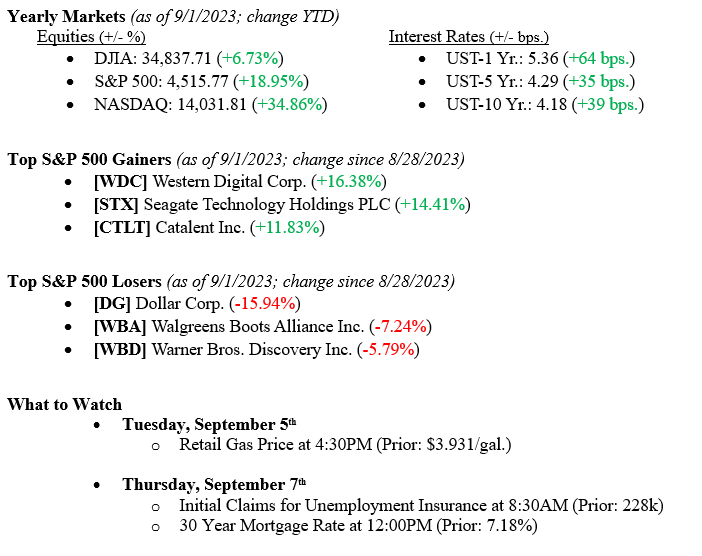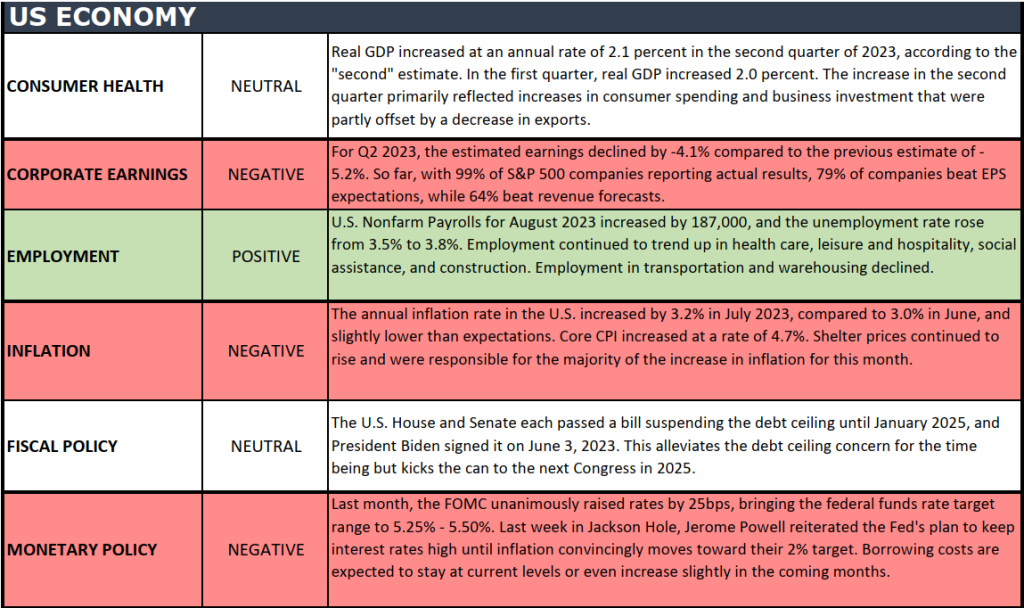“The secret of getting ahead is getting started. The secret to getting started is breaking your complex overwhelming tasks into small manageable tasks and then starting on the first one.”― Mark Twain
“Your Financial Choices”
Tune in Wednesday, 6 PM “Your Financial Choices” on WDIY 88.1FM. Laurie will be discussing: Milestone Birthdays – Important Ages in Planning.
Questions can be submitted at yourfinancialchoices.com in advance of the live show. Recordings of past shows are available to listen or download at both yourfinancialchoices.com and wdiy.org.
Current Market Observations
U.S. stocks ended the week essentially flat. The Dow Jones Industrial Average gained 0.12% on the week, the S&P 500 lost 0.16%, and the NASDAQ fell 0.39%. Last week, U.S. inflation grew to 3.67% from 3.18% the month prior. Additionally, mortgage rates climbed to an average of 7.18% from 7.12%, the highest rate since May 2001. It’s also worth noting that the Index of Consumer Sentiment, a survey of general economic outlook based on a random sample of U.S. households, has fallen to 67.70, a slight drop from the prior month but still significantly ahead from a year ago when it was 58.60 (the higher consumer sentiment, the better). These reports coincide with a slight sell-off in bonds, with the 10-year U.S. Treasury ending the week at 4.33%, seven basis points higher than last Friday. As always, please reach out to your advisor at Valley National Financial Advisors with any questions or concerns.

Global Economy
Though the Federal Reserve has raised rates by more than 500 basis points since January 2022, there has been a limited slowdown in US consumer demand. With the most recent inflation number gaining month-over-month, policymakers are beginning to look at rates from a new perspective: what do rate hikes mean for the supply side of the economy? The argument is that if rates rise too high, they could potentially undermine the benefits of increasing supply, as discussed in a paper presented at Jackson Hole last month. Despite this, we expect the Fed to remain data-driven in its battle to bring inflation down to the 2% target—it is unlikely that they will act solely on this argument moving forward when their action plan has proven relatively effective. Chart 1 below shows the components of inflation that are driven by either demand or supply.

As of July, Mexico has overtaken China as the United States’s largest trade partner, representing 15% of U.S. imports (versus China’s 14.6%). Chart 2 below shows the trend in U.S. imports since 2017. As U.S.-China relations soured, the share of imports from Mexico and Canada increased significantly over the last six years, making nearshoring to Mexico a much more attractive option. Chart 3 is a map of major industrial parks that produce goods that eventually make their way into the United States—it’s no surprise that most of them are located near the border. As investment into these industrial parks increased, so did the U.S.’s dependence on Mexican goods. Since 2017, all categories of imports have increased except for food and electrical equipment, which decreased. Chart 4 shows each import category and their respective sizes. Chart 5 shows the change in investment in heavy machinery in Mexico since 1993—notice the sharp decline from when tariffs on Chinese goods began in 2018 through 2020 and then the sharp rise once the USMCA was enacted in place of NAFTA.




What to Watch
- Monday, Sept. 18th
- 4:30PM – Retail Gas Price (Prior: $3.941/gal.)
- Tuesday, Sept. 19th
- 8:30AM – Housing Starts (Prior: 3.86%)
- 10:00AM – Job Openings: Total Nonfarm (Prior: 8.827M)
- Wednesday, Sept. 20th
- 2:30PM – Target Federal Funds Rate (Prior: 5.25-5.50)
- Thursday, Sept. 21st
- 8:30AM – Initial Claims for Unemployment (Prior: 220k)
- 10:00AM – Existing Home Sales (Prior: 4.07M)
- 12:00PM – 30 Year Mortgage Rate (Prior: 7.18%)
The Numbers & “Heat Map”

Sources: Index Returns: Morningstar Workstation. Past performance is no guarantee of future results. Indices are unmanaged and cannot be invested into directly. Three, five- and 10- year returns are annualized excluding dividends. Interest Rates: Federal Reserve, Mortgage Bankers Association.
MARKET HEAT MAP
The health of the U.S. economy is a key driver of long-term returns in the stock market. Below, we grade key economic conditions that we believe are of particular importance to investors.


The “Heat Map” is a subjective analysis based upon metrics that VNFA’s investment committee believes are important to financial markets and the economy. The “Heat Map” is designed for informational purposes only and is not intended for use as a basis for investment decisions.
Quote of the Week
“It is often the small steps, not the giant leaps, that bring about the most lasting change.” –Queen Elizabeth II
“Your Financial Choices”
Tune in Wednesday, 6 PM “Your Financial Choices” on WDIY 88.1FM. Laurie will be discussing: Understanding Debt – What do you have?
Questions can be submitted at yourfinancialchoices.com during or in advance of the live show. Recordings of past shows are available to listen or download at both yourfinancialchoices.com and wdiy.org.
Current Market Observations
Equity markets ended the week a bit higher, with the Dow Jones Industrial Average gaining 1.43%, the S&P500 notching a 2.50% gain, and the NASDAQ ending up 3.25%. The continued positive momentum in the economy and lessening chances for another rate hike by the Federal Reserve in September added some needed optimism to the markets. Trading was quiet in front of the Labor Day Holiday Weekend, but things got back to normal this week. With less than four months of trading left in the year, Wall Street will be getting back to business. Watch for important market moves and salient economic releases as we move forward this week.

Did You Know…? The Importance of Navigating Cybersecurity? Part 4
The Importance of Navigating Cybersecurity?
Essential Cybersecurity Measures for Clients (a five-part series)
By: Rob Ziobro, VNFA Assistant Vice President, Technologies
This week, I would like to remind you to Be Mindful of the Information You Share: Social media platforms encourage sharing, but oversharing can put you at risk. Cybercriminals can piece together personal information from various sources to orchestrate targeted attacks. Be cautious about what you post online, especially details like your full birthdate, home address, or vacation plans.

Be sure to check back next week as we conclude this series. I hope you all had an enjoyable and safe Labor Day weekend.
The Numbers & “Heat Map”

Sources: Index Returns: Morningstar Workstation. Past performance is no guarantee of future results. Indices are unmanaged and cannot be invested into directly. Three, five- and 10- year returns are annualized excluding dividends. Interest Rates: Federal Reserve, Mortgage Bankers Association.
MARKET HEAT MAP
The health of the U.S. economy is a key driver of long-term returns in the stock market. Below, we grade key economic conditions that we believe are of particular importance to investors.


The “Heat Map” is a subjective analysis based upon metrics that VNFA’s investment committee believes are important to financial markets and the economy. The “Heat Map” is designed for informational purposes only and is not intended for use as a basis for investment decisions.
Quote of the Week
“There is something so special in the early leaves drifting from the trees–as if we are all to be allowed a chance to peel, to refresh, to start again.”– Ruth Ahmed
